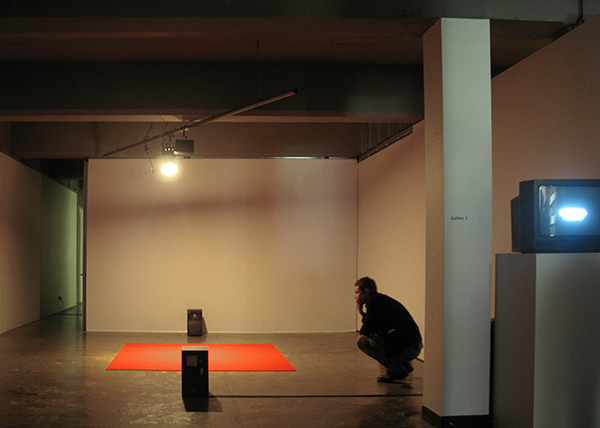A site specific installation
version 2.2 Bluray PCM 5.1 (details here presented at Somn, centro cultural Puertas de Castilla, Murcia, Spain, September-October 2011 VIDEO 1
version 2.1 DVD Dolby Digital 5.1 (details here) presented at light and sound gallery at Portland Art Center, USA, February-march 2007
version 1.1 (3 screens/12 speakers/3 spaces) presented at West Space Gallery, during Liquid Architecture festival, Melbourne, july 2005
english / french book book edited by Passage d'encres Distribution Les Presses du réel - Chronique-Review
Version 1.1

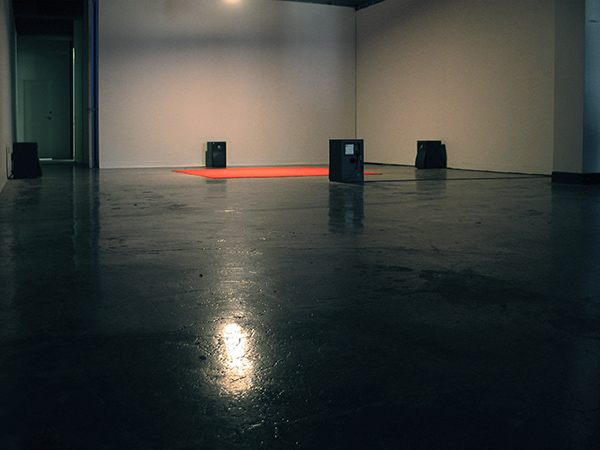
presentation : "to organize visibility"
The installation is defined as a representation of specific environment through sound: on the one hand, the gallery, on the other hand, the city of Melbourne.
While working on the questions of measurement, sound questions what makes a landscape. How can sound decipher the world and objectify the reality ? How can sound teach us of the absent realities from a visible landscape ? ... To leave perception from "the ruts of the result" (Rene Char) ?
By a sound mapping of the city, this project initiates a measurement through listening. Our device involves a pointillist dematerialization of this territory and tracing from it a derived map. In contact with these new territories, it creates another awareness of what confronts and often submerges the listener.
On the question of seeing, Anne Cauquelin : "trapped innocently, we didn't contemplated one exteriority, as we believed it, but our own intellectual factories. Believing to leave ourselves by a providential extase, we simply entered in admiration for our own way of seeing." (in L'invention du paysage, Ed. PUF Col. Quadrige 2000)
And Jean-Marc Besse : "a geometrical problem, that of mastering proportion, but also an exercise in thought and perception, which consists of knowing how to judge the real size of the things, their true size."
The sound renders topophonic diagnosis impossible. Nevertheless it reveals a geophonic course of / in the city : a geophony of an invisible territory. To such a degree that the listener can question the existence of the places visited. The question of reality induces that of the proof, signature. Sound reveals and qualifies (signs) more than it authenticates and justifies.
1 The Cardinal Points of the city
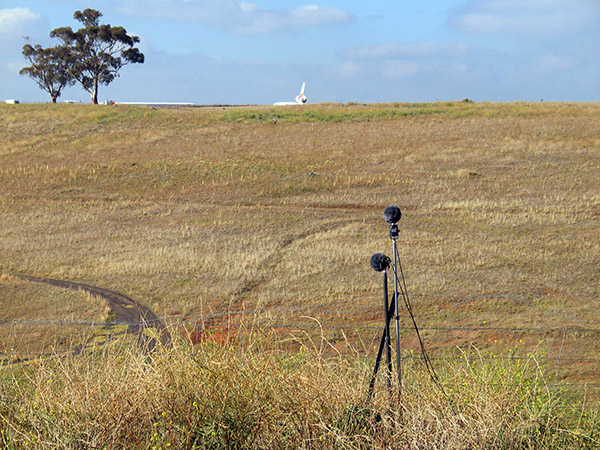 airport
airportnorth : Melbourne airport
south : Williamstown - seashore
east : Tremont - Dandenong ranges national park
west : Weeribee - highway
Recordings
objectivity
Each place is selected for its acoustic, and geographical characteristics. By the territorial limits of the city, we seek landscapes where the sound objects become scattered. Monochromic sound, monophony, the 4 hours - 1 hour by point by speaker - are diffused in gallery 1 (the largest space) such as they were recorded.
Processings
During each recording, events intervene and define a whole of appearance in the monochromic global structure. These sound objects which emerge from the 4 monochromes will define the formal / musical structure of all the installation. According to the emerging objects of the 4 cardinal points, movements appear in the 3 galleries. The sounds of gallery 3 will circulate in the gallery 2 then 1, while the sine waves of gallery 2 strat at this time. The duration of these movements in the other galleries is determined by the duration of the events of the 4 cardinal points.
2 CBD Melbourne Center


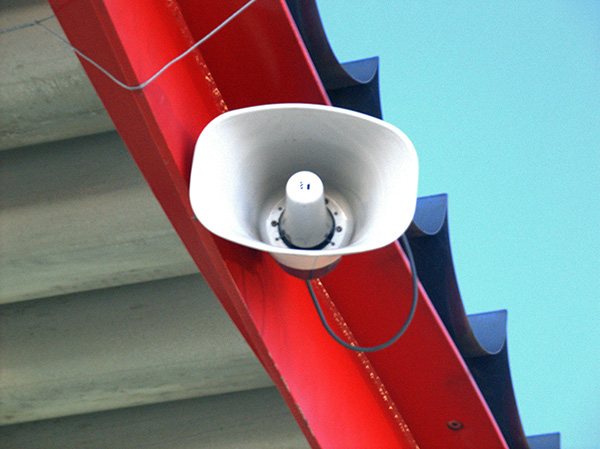
a sound journey
City Circle tram, Flinders St Station, QV Center, Queen Victoria Market, Telstra Dome, Parliament House, Wesley church, RMIT campus, Melbourne Central, State Library of Victoria…
Recordings
subjectivity
We surveyed the heart of Melbourne, CBD, the ears in the wind, without preset course until the exhaustion of all the streets. Each sound recording sign a microscopic territory of the city. In counterpoint of the 4 cardinal recordings we sought a myriad of sounds or acoustic details of the centre. The 150 sound recordings, carried out during one week in 45 places, offer a microscopic listening of reality. The macroscopic legibility of the CBD leaves place to an inner pointillism. The visible world, objectified by the eyes, is tested by our subjective listening until its disappearance in the field of the musical one.
Processing
The pedestrian trajectory (strategy) of our daily recordings in the CBD defines a complete sound cycle - 45 places. Then the calibration of the sounds consists with the cartographic follow-up of this trajectory until the exhaustion of materials/sounds. Each sound recording is cut out in a subjective way then assembled to the preceding one without transition or modifications of volume. A succession of rough recordings. The total duration of each cycle (there are 4 cycles during 1 hour and 20 minutes) is determinated by the number of materials from place 1 (City circle tram), to place 45 (Swanston St) during a demonstration. According to the events of gallery 1 (cardinal points) the sounds are propagated towards the other galleries.
3 Measurement
Calculation . Processing
From the plan of the gallery, we know the size of its rooms - the numerical dimensions. Sinusoidal frequencies are deduced from these metric measurements. The frequencies are established according to two joint principles : on the one hand the standing wave of the particular spaces (lenght, width, height of galleries 1 to 3), on the other hand various dimensions of space, diagonals of each wall and diagonal of each space itself.
example of calculation : gallery 1
Lenght = 10 meters
Width = 5,95 meters
Height = 3,45 meters
Once you know the speed of sound (342 m/s) you can calculate the frequencies :
Lenght = 10 meters à 342/10= 34 Hz
Width = 5,95 meters à 57 Hz
Height = 3,45 meters à 99 Hz
You can add the diagonals.
Lenght/width = 11,63 à29 Hz
Lenght/Height = 10,57 à32 Hz
Width/Height = 6,87 à49 Hz
Lenght/Width/Height = 12,13 à28Hz
And finally you add the first 9 harmonic frequencies.
For example : lenght : 34-68-136-272-544-1088-2176-4352-8704-17408
According to the events of gallery 1 (cardinal points) the sounds are diffused in gallery 2 at the same time as the movements from gallery 3 into the others galleries.
Each cycle ends with the sound of a demonstration in gallery 3, all sounds in galleries 1 & 2 stop. Then begins a transitory sequence - with the next cycle - only of sine waves. The sine waves corresponding to each room are played and disappear gradually while the frequency corresponding to the height passes slowly from one speaker to the other.
4 voice
From the entrance of the gallery, one voice is heard. The nature of the recording (on a dictaphone recorder), the tone of this voice and the words read build its specific space on one loudspeaker. Eamon Sprod- the voice, reads words from the photographs in gallery 3. This list of words is played continuously. The voice moves between two cycles from the entrance to gallery 3 and is played in the room where the photographs of the words are located
5 images
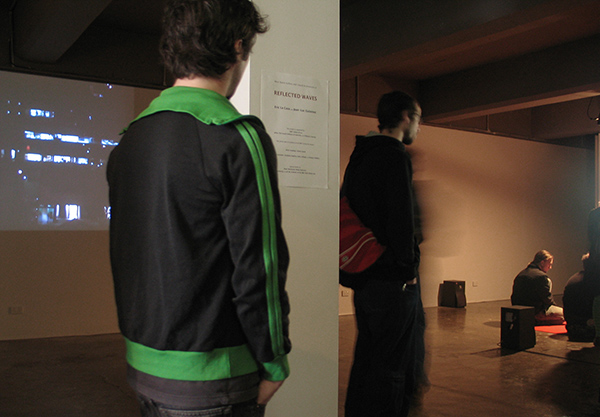 gallery 1
gallery 1In gallery 1 a fixed camera shot of 1 hour 30 minutes is played, while photographs annex two monitors in the entrance and gallery 3.
The film is a fixed camera shot of an office building and a carpark at dawn. Cars, individuals, the lights... an accountancy, a measurement of the city - a surveillance too.
The photographs have two subjects: places of recordings, and words found in the city. On the one hand, after each recording, if we can do it, a photograph returns an account of a reality of the place. Framing voluntarily brings to the centre of attention what has induced the sound. Like sound, photography does not document but approaches what has just made the sound. On the other hand, a series of photographs shows some of the words that were found in the city; like a subjective measure of their power of representation in the urban space.
 cbd melbourne
cbd melbourneEVENT TIME FREQUENCIES
1 lenght of gallery 1
2 width 1
3 height
4 LWH 1
5 lenght 2
6 width 2
7 height
8 LWH 2
9 lenght 3
10 width 3
11 height
-------------------------------------------------------------------------
12 LWH 3
13 L1+W1 to diagonal (Da1)
14 L1+H to diagonal (Db1)
15 W1+H to diagonal (Dc1)
16 L1+W1+H to diagonal (Dd1)
17 L2+W2 to Da2
18 L2+H to Db2
19 W2+H to Dc2
20 L3+W3+H to Dd3
-------------------------------------------------------------------------
21 L3+W3 to Da3
22 L3+H to Db3
23 W3+H to Dc3
24 L3+W3+H to Dd3
25 4 diagonals of gallery 1
26 4 diagonals of gallery 2
27 4 diagonals of gallery 3
28 Da of the 3
29 Db of the 3
30 Dc of the 3
31 Dd of the 3
32 all the diagonals
33
34
35
36
37
38
39
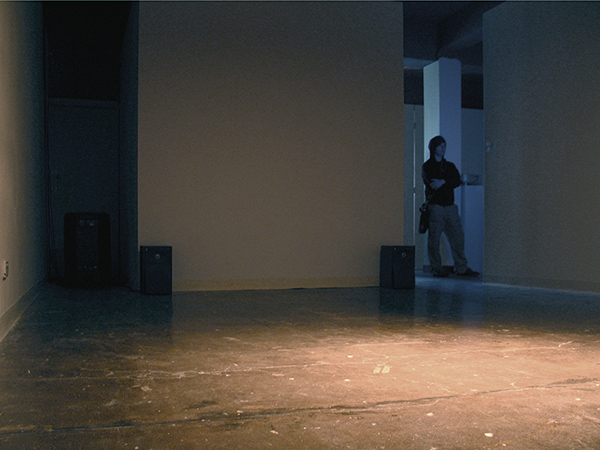 gallery 2
gallery 2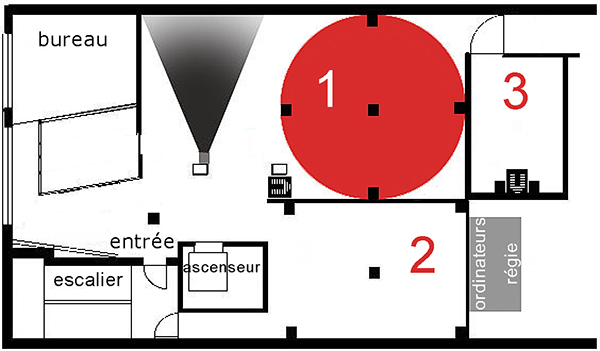
PRODUCTION : West Space Gallery and Liquid Architecture 6 (Melbourne, Australia)
This project is supported by :
RMIT school of art,
AFAA, The French Embassy of Australia, and L’Alliance Francaise
The artists were in residence at the RMIT during the process
Voice (reading) : Eamon Sprod
Technical assistant : Jonathan Hopkins, Kaila Gollogly, and Dominic Redfern
Special thanks to :
Peter Westwood, Philip Samartzis,
Jen Sochackyj, and all the students of the RMIT Multi Media Arts
